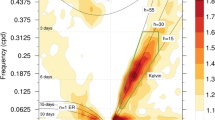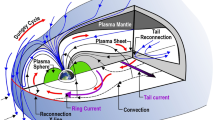Abstract
The relation between the intensity of the East Asian trough and the strength of the East Asian winter monsoon is documented. A prominent dipole of the available potential energy of the zonal mean flow can be observed over the midlatitudes and polar regions and is related to temperature anomalies. Variation in the intensity of the East Asian trough is caused by variation in the energy conversion from the available potential energy of the zonal mean flow to the East Asian trough. The in-phase relation between the intensities of the East Asian jet and East Asian trough is illustrated by the relation between the potential energy and kinetic energy of stationary eddies. The dipole of height anomalies over the midlatitude and polar regions develops in late autumn and decays in early spring. We investigate the effect of both stationary and transient eddy forcing on the evolution of the dipole. The combined forcing of the two types of eddy makes an important contribution to the development, maintenance, and decay of the dipole.
















Similar content being viewed by others
References
Chang EKM (2001) GCM and observational diagnoses of the seasonal and interannual variations of the Pacific storm track during the cool season. J Atmos Sci 58:1784–1800
Chen W, Graf H-F, Takahashi M (2002) Observed interannual oscillations of planetary wave forcing in the Northern Hemisphere winter. Geophys Res Lett 29(22):30–31
Chen W, Yang S, Huang R-H (2005) Relationship between stationary planetary wave activity and the East Asian winter monsoon. J Geophys Res 110:D14110
Chen S, Chen X, Wei K, Chen W, Zhou T (2014) Vertical tilt structure of East Asian trough and its interannual variation mechanism in boreal winter. Theor Appl Climatol 115:667–683
Cheung HN, Zhou W, Mok HY, Wu MC (2012) Relationship between Ural-Siberian blocking and the East Asian winter monsoon in relation to the Arctic oscillation and the El Niño-Southern oscillation. J Climate 25:4242–4257
Cheung HN, Zhou W, Mok HY, Wu MC, Shao Y (2013) Revisiting the climatology of atmospheric blocking in the Northern Hemisphere. Adv Atmos Sci 30:397–410
Ding Y (1994) Monsoons over China. Kluwer Academic Publishers, Berlin
Ding Y, Krishnamurti TN (1987) Heat budget of the Siberian high and the winter monsoon. Mon. Wea. Rev. 115:2428–2449
Gong D-Y, Wang S-W, Zhu J-H (2001) East Asian winter monsoon and Arctic Oscillation. Geophys Res Lett 28:2073–2076
Held IM (1983) Stationary and quasi-stationary eddies in the extratropical troposphere: Theory. In: Hoskins BJ, Pearce RP (eds) Large-scale dynamical processes in the atmosphere. Academic Press, London, pp 127–168
Hoskins BJ, James IN, White GH (1983) The shape, propagation and mean-flow interaction of large-scale weather systems. J Atmos Sci 40:1595–1612
Hu Q, Tawaye Y, Feng S (2004) Variations of the Northern Hemisphere atmospheric energetics: 1948–2000. J Clim 17:1975–1986
Jacqmin D, Lindzen RS (1985) The causation and sensitivity of the northern winter planetary waves. J Atmos Sci 42:724–745
Jhun J-G, Lee E-J (2004) A new East Asian winter monsoon index and associated characteristics of the winter monsoon. J. Climate 17:711–726
Kalnay E et al (1996) The NCEP/NCAR 40-year reanalysis project. Bull. Amer. Meteor. Soc. 77:437–471
Kim Y-H, Kim M-K (2013) Examination of the global Lorenz energy cycle using Merra and NCEP-reanalysis 2. Clim Dyn 40:1499–1513
Lau NC (1979a) The observed structure of tropospheric stationary waves and the local balances of vorticity and heat. J Atmos Sci 36:996–1016
Lau NC (1979b) The structure and energetics of transient disturbances in the Northern Hemisphere wintertime circulation. J Atmos Sci 36:982–995
Lau NC (1988) Variability of the observed midlatitude storm tracks in relation to low-frequency changes in the circulation pattern. J Atmos Sci 45:2718–2743
Leung MY-T, Cheung HH, Zhou W (2014) Energetics and dynamics associated with two typical mobile trough pathways over East Asia in boreal winter. Clim Dynam. doi:10.1007/s00382-014-2355-6
Li YC (1990) Interaction between anomalous winter monsoon in East Asia and El Niño events. Adv Atmos Sci 7:36–46
Lorenz EN (1955) Available potential energy and the maintenance of the general circulation. Tellus 7:157–167
Nakamura H (1992) Midwinter suppression of baroclinic wave activity in the Pacific. J Atmos Sci 49:1629–1642
Nakamura H, Shimpo A (2004) Seasonal variations in the Southern Hemisphere storm tracks and jet streams as revealed in reanalysis dataset. J. Climate 17:1828–1844
Nigam S, Held IM, Lyons SW (1986) Linear simulation of stationary eddies in a general circulation model. Part I: the no-mountain model. J Atmos Sci 43:2944–2961
Nigam S, Held IM, Lyons SW (1988) Linear simulation of the stationary eddies in GCM. Part II: the “mountain” model. J Atmos Sci 45:1433–1452
Peixoto JP, Oort AH (1974) The annual distribution of atmospheric energy on a planetary scale. J Geophys Res 79:2149–2159
Plumb RA (1985) On the three-dimensional propagation of stationary waves. J Atmos Sci 42:217–229
Plumb RA (1986) Three dimensional propagation of transient quasi-geostrophic eddies and its relationship with the eddy forcing of the time-mean flow. J Atmos Sci 43:1657–1670
Randel WJ, Stanford JL (1985a) An observational study of medium-scale wave dynamics in the Southern Hemisphere summer. Part I: wave structure and energetics. J Atmos Sci 42:1172–1188
Randel WJ, Stanford JL (1985b) The observed life cycle of a baroclinic instability. J Atmos Sci 42:1364–1373
Saltzman B (1957) Equations governing the energetics of the larger scales of atmospheric turbulence in the domain of wavenumber. J. Meteor. 14:513–523
Saltzman B (1970) Large atmospheric energetics in the wave-number domain. Rev Geophys Space Phys 8:289–320
Seager R, Harnik N, Kushnir Y, Robinson W, Miller J (2003) Mechanisms of hemispherically symmetric climate variability. J. Climate. 16:2960–2978
Simmons AJ (1982) The forcing of stationary wave motion by tropical diabatic heating. Quart. J. Atmos. Roy. Meteor. Soc. 108:503–534
Simmons AJ, Hoskins BJ (1978) The life cycles of some nonlinear baroclinic waves. J Atmos Sci 35:414–432
Simmons AJ, Hoskins BJ (1980) Barotropic influences on the growth and decay of nonlinear baroclinic waves. J Atmos Sci 37:1679–1684
Takaya K, Nakamura H (2013) Interannual variability of the East Asian winter monsoon and associated modulations of the planetary waves. J. Climate 26:9445–9461
Trenberth KE (1986) An assessment of the impact of transient eddies on the zonal flow during a blocking episode using localized Eliassen-Palm flux diagnostics. J Atmos Sci 43:2070–2087
Ulbrich U, Speth P (1991) The global energy cycle of stationary and transient atmospheric waves: results from ECMWF analyses. Meteorol Atmos Phys 45:125–138
Van Loon H (1979) The association between latitudinal temperature gradient and eddy transport Part I: transport of sensible heat in winter. Mon. Wea. Rev. 107:525–534
Wallace JM, Gutzler DS (1981) Teleconnections in the geopotential height field during the Northern Hemisphere winter. Mon. Wea. Rev. 109:784–812
Wang L, Chen W, Zhou W, Huang RH (2009) Interannual variations of East Asian trough axis at 500 hPa and its association with the East Asian winter monsoon pathway. J. Climate 22:600–614
Wang B, Wu Z, Chang C-P, Liu J, Li J, Zhou T (2010) Another look at interannual to interdecadal variations of the East Asian winter monsoon: the northern and southern temperature modes. J. Climate 23:1495–1512
Wu B-Y, Wang J (2002a) Possible impacts of winter Arctic Oscillation on Siberian high, the East Asian winter monsoon and sea-ice extent. Adv Atmos Sci 19:297–320
Wu B-Y, Wang J (2002b) Winter arctic oscillation, Siberian high and East Asian winter monsoon. Geophys Res Lett 29:1897. doi:10.1029/2002GL015373
Zhang Y, Sperber KR, Boyle JS (1997) Climatology and interannual variation of the East Asian winter monsoon: results from the 1979–95 NCEP/NCAR reanalysis. Mon Wea Rev 125:2605–2619
Zhou W, Wang X, Zhou TJ, Li CY, Chan JCL (2007) Interdecadal variability of the relationship between the East Asian winter monsoon and ENSO. Meterorol Atmos Phys 98:283–293
Zhou W, Chan JCL, Chen W, Ling J, Pinto JG, Shao Y (2009) Synoptic-scale controls of persistent low temperature and icy weather over southern China in January 2008. Mon. Wea. Rev. 137:283–293
Acknowledgments
The first author is a recipient of a research studentship provided by the City University of Hong Kong. This study is supported by the National Nature Science Foundation of China Grant 41175079 and 41375096, and CityU Strategic Research Grant 7004004.
Author information
Authors and Affiliations
Corresponding author
Rights and permissions
About this article
Cite this article
Leung, M.YT., Zhou, W. Vertical structure, physical properties, and energy exchange of the East Asian trough in boreal winter. Clim Dyn 45, 1635–1656 (2015). https://doi.org/10.1007/s00382-014-2419-7
Received:
Accepted:
Published:
Issue Date:
DOI: https://doi.org/10.1007/s00382-014-2419-7




